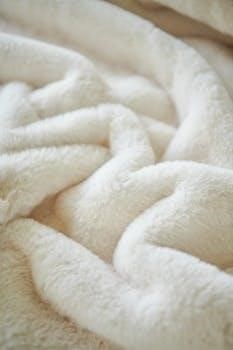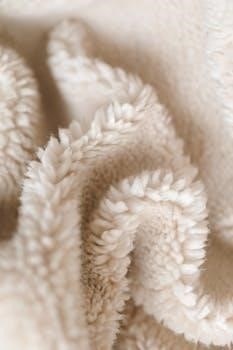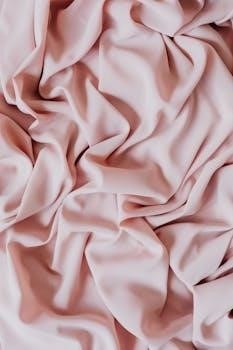No Sew Fleece Blanket Instructions PDF⁚ A Comprehensive Guide
Crafting a cozy no-sew fleece blanket is a simple and rewarding project. This guide offers comprehensive instructions, often available as a downloadable PDF, ensuring clarity and ease. With readily available materials and easy-to-follow steps, creating a warm, personalized blanket becomes an enjoyable experience for crafters of all skill levels.
No-sew fleece blankets have surged in popularity due to their simplicity and comforting appeal. These blankets require no sewing, making them an ideal project for beginners and experienced crafters alike. The basic concept involves layering two pieces of fleece fabric and creating a fringed edge, which is then tied or braided together. This method eliminates the need for sewing machines or intricate stitching techniques.
The beauty of no-sew fleece blankets lies in their versatility. They can be customized with various colors, patterns, and sizes, catering to individual preferences and needs. Whether you’re creating a cozy throw for your living room, a warm blanket for a child, or a thoughtful gift for a loved one, the possibilities are endless.
Moreover, no-sew fleece blankets are not only easy to make but also incredibly soft and warm. Fleece fabric is known for its plush texture and excellent insulation properties, providing comfort and warmth during chilly days and nights. This makes them a practical and cherished addition to any household.
The accessibility and ease of construction make no-sew fleece blankets a perfect project for group activities, such as crafting sessions with friends or family, or even as a charitable endeavor, creating blankets for those in need. With minimal supplies and straightforward instructions, anyone can create a beautiful and functional fleece blanket.
Materials Needed for a No Sew Fleece Blanket
Creating a no-sew fleece blanket requires a few essential materials, ensuring a smooth and enjoyable crafting experience. The primary component is, of course, fleece fabric. Typically, two coordinating pieces of fleece are used to add visual interest and warmth. The amount of fleece needed will vary depending on the desired size of the blanket, ranging from smaller sizes for babies to larger dimensions for adults.
Next, a good pair of scissors is crucial for making clean and precise cuts. Sharp fabric scissors or a rotary cutter paired with a cutting mat are ideal for creating even fringe. A ruler or measuring tape is also necessary to ensure accurate measurements when cutting the fabric and fringe.
Additionally, some crafters find it helpful to use masking tape to mark the cutting lines for the fringe, ensuring uniformity and straight cuts. A pen or marker can also be used for this purpose. While not strictly necessary, a corner tracer or a square piece of cardboard can aid in cutting out the corners of the fleece, providing a neat and professional finish.
Finally, optional embellishments such as labels or decorative thread can be added to personalize the blanket further. With these basic materials in hand, you’ll be well-equipped to create a cozy and beautiful no-sew fleece blanket.
Cutting the Fleece Fabric
The initial step in creating a no-sew fleece blanket involves accurately cutting the fleece fabric. Begin by laying both pieces of fleece on a flat surface, ensuring they are aligned with wrong sides together. This allows you to cut both layers simultaneously, saving time and ensuring uniformity. Trim off any selvages, which are the finished edges of the fabric, using sharp scissors or a rotary cutter.
Next, square off the ends of the fleece, creating a clean and even rectangle. Use a ruler or measuring tape to measure and mark the desired dimensions of the blanket. For different blanket sizes, adjust the measurements accordingly, considering the intended recipient, whether it’s a baby, child, or adult.
Once the fleece is squared and trimmed, the next step is to cut out a square from each corner. This creates the space for the fringe that will be tied or braided later. Typically, a 4-inch square is removed from each corner, but this can be adjusted based on personal preference.
Use a corner tracer or a square piece of cardboard as a guide to ensure accurate and consistent cuts. Precise cutting is essential for a professional-looking finished product. Taking the time to carefully measure and cut the fleece fabric sets the foundation for a beautiful and cozy no-sew blanket.

Creating the Fringe

Creating the fringe is a crucial step in making a no-sew fleece blanket, adding both decorative appeal and structural integrity. After cutting the fleece fabric and removing the corner squares, the next task is to cut strips along all four sides of the blanket. These strips form the fringe that will be tied or braided together.
Using a ruler or measuring tape, mark the desired length and width of the fringe strips. Typically, the strips are cut 4 to 5 inches deep and about 1 inch wide. Consistent measurements are key to achieving a uniform and professional look. Use a fabric marker or chalk to mark the cutting lines, ensuring they are straight and evenly spaced.
With the cutting lines marked, carefully cut along each line through both layers of fleece fabric. A sharp pair of scissors or a rotary cutter can be used for this task. If using scissors, ensure they are long and sharp enough to cut through both layers smoothly. A rotary cutter, paired with a cutting mat, offers precision and speed, especially when making multiple blankets.
Take your time and focus on cutting straight lines. Uneven fringe strips can detract from the overall appearance of the blanket. Once all the strips are cut, you’ll have a fringe border ready for tying or braiding, transforming your fleece pieces into a cozy, personalized blanket.

Tying or Braiding the Fringe⁚ Different Techniques
Once the fringe is cut, the next step is to secure it using various tying or braiding techniques. These methods not only add a decorative touch but also prevent the fleece from fraying. One popular technique involves simple knotting. Take the top and bottom fleece strips and tie them together in a basic overhand knot. Ensure each knot is snug but not too tight to avoid puckering the blanket’s edge.
Another approach is the square knot, which provides a more secure and decorative finish. To create a square knot, tie the top and bottom strips in a right-over-left knot, then a left-over-right knot. This method results in a flat, even knot that is less likely to come undone.
Braiding offers a different aesthetic. Divide each set of fringe strips into three smaller strands and braid them together. Secure the end of each braid with a small knot or a piece of thread. Braiding adds texture and visual interest to the blanket’s edge.
For a unique look, consider the loop technique. Create a loop with each set of fringe strips and pull the ends through to form a knot. This method produces a chunky, textured border. Experiment with different techniques to find the one that best suits your style and the overall design of your no-sew fleece blanket.
Size Options for Different Needs (Baby, Child, Adult)
When creating a no-sew fleece blanket, selecting the right size is crucial for its intended use. For a baby blanket, a common size is around 30×36 inches. This provides ample coverage for swaddling or use in a crib without being too large or cumbersome. A slightly larger size, such as 36×45 inches, can also be used for added versatility as the baby grows.
For children, a size of 45×60 inches is often ideal. This allows the blanket to be used comfortably for cuddling on the couch, as a lap blanket during car rides, or even as a small bed covering. The increased size provides more warmth and coverage compared to a baby blanket.
Adult-sized no-sew fleece blankets can vary widely depending on personal preference and intended use. A throw blanket size, around 50×60 inches, is perfect for snuggling up on the sofa. For a twin-sized bed blanket, consider dimensions of approximately 66×90 inches.
Those seeking a larger blanket for full coverage or to share might opt for a queen-sized blanket, typically around 90×90 inches. Ultimately, the best size depends on individual needs and desired functionality. Measuring the intended recipient or the space where the blanket will be used can help determine the most appropriate dimensions.
Design Ideas and Fabric Combinations
The beauty of no-sew fleece blankets lies in their versatility, especially regarding design and fabric combinations. One popular approach involves pairing a patterned fleece with a solid color fleece for a visually appealing contrast. For example, a blanket might feature a playful print with animals or characters on one side and a calming, complementary color on the other.
Another idea is to use two different patterns that complement each other. Consider pairing a subtle geometric print with a floral pattern or stripes. To ensure a cohesive look, choose fabrics with similar color palettes or coordinating hues. This adds depth and interest to the blanket without overwhelming the senses.
For themed blankets, consider fabrics that reflect the recipient’s interests or hobbies. Sports teams, favorite movies, or nature scenes can all inspire fabric choices. Seasonal designs, such as snowflakes for winter or pumpkins for autumn, are also popular.
Mixing textures can add another dimension to the blanket. Although both sides are typically fleece, consider using different types of fleece, such as a plush, high-pile fleece on one side and a smoother, anti-pill fleece on the other. This can enhance the tactile experience and make the blanket even more comforting.
Personalization is key to creating a unique no-sew fleece blanket. Adding monograms, appliques, or decorative stitching around the edges can elevate the design.
Tips for Ensuring Straight Cuts and Even Fringe

Achieving professional-looking results with a no-sew fleece blanket hinges on precise cutting and consistent fringe. One of the best tips for straight cuts is to use a rotary cutter, a self-healing cutting mat, and a clear acrylic ruler. This combination allows you to glide through the fleece with ease, ensuring clean, straight lines. If you don’t have a rotary cutter, sharp fabric scissors are essential.
Before cutting, ensure your fleece is lying flat on a smooth surface. Use weights or pins to secure the fabric and prevent shifting. Measure and mark your cutting lines with a fabric marker or tailor’s chalk. For long cuts, consider using a long quilting ruler to maintain accuracy.
When cutting the fringe, consistency is key. Use a ruler or a pre-made fringe template to mark the width and depth of each fringe strip. Aim for uniform strips, typically 1 inch wide and 4-5 inches deep. Cutting through both layers of fleece simultaneously can save time, but make sure the layers are perfectly aligned to avoid uneven fringe.
If you’re using scissors, make long, smooth cuts rather than short, choppy ones. This will create a cleaner, more professional look. After cutting the fringe on all sides, take a moment to trim any uneven pieces. This will give your blanket a polished finish.
If you find it challenging to cut straight lines freehand, consider using masking tape as a guide. Apply the tape along your cutting lines and follow the edge with your scissors or rotary cutter.
Care Instructions for Your No Sew Fleece Blanket
Maintaining the softness and longevity of your no-sew fleece blanket requires proper care. Fleece is generally easy to care for, but following these guidelines will help keep your blanket looking its best. Machine washing is typically safe, but always check the fabric’s care label for specific instructions. Use cold water and a mild detergent to prevent fading and damage to the fibers.
Avoid using bleach or fabric softeners, as these can break down the fleece and reduce its softness. For best results, wash the blanket separately or with similar items to prevent lint transfer. Tumble dry on a low heat setting or air dry to avoid shrinking or warping the fabric.
If you choose to tumble dry, remove the blanket promptly to prevent wrinkles. Avoid ironing fleece, as the heat can melt the fibers. If necessary, use a cool iron with a pressing cloth. To remove stains, treat them as soon as possible with a mild stain remover. Gently blot the stain, avoiding harsh rubbing, which can damage the fleece.
For stubborn stains, consider soaking the blanket in cold water with a mild detergent before washing. To prevent pilling, wash the blanket inside out. Regularly check the fringe for any loose or frayed pieces and trim them as needed. Store the blanket in a cool, dry place away from direct sunlight to prevent fading.
Comments